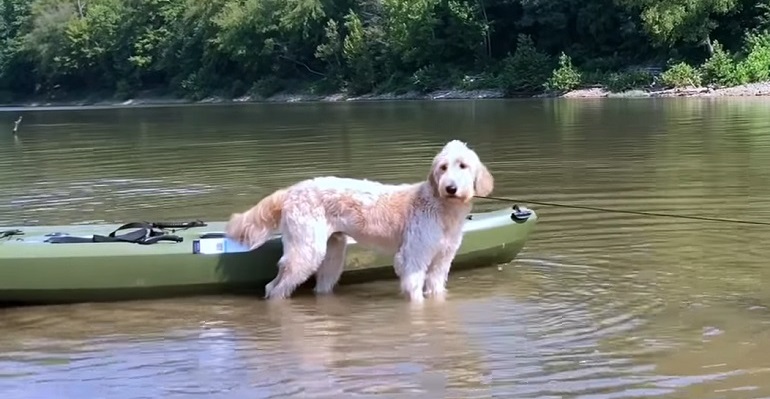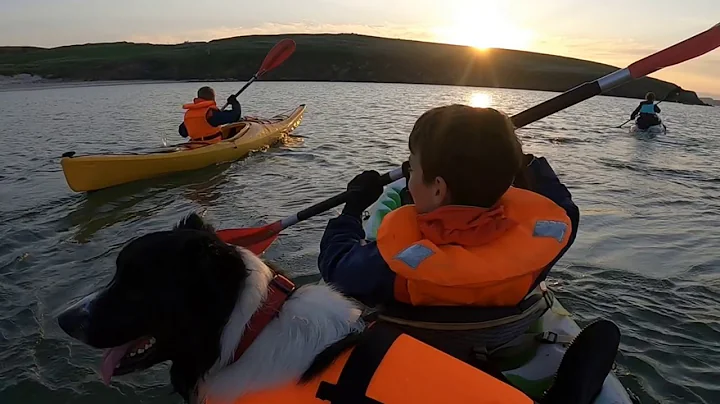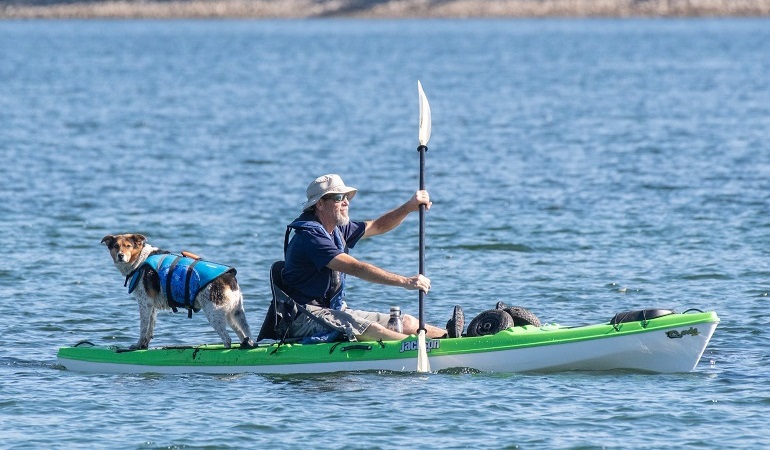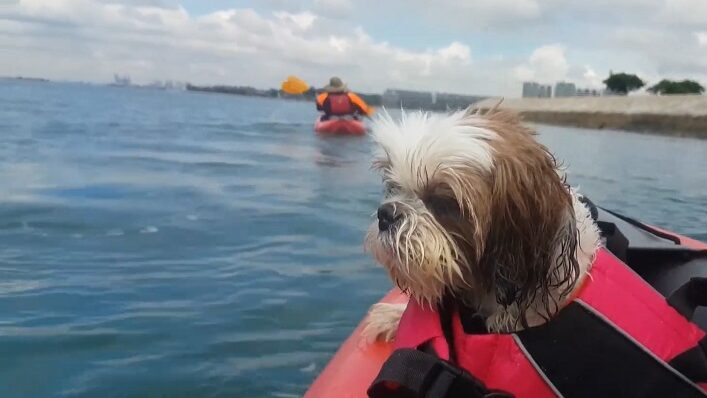Our furry friends enjoy sharing outdoor adventures with us as much as we do.
I’ve often seen many dogs surfing or even kitesurfing together with their favorite person. They are so confident and natural on the board, looking almost like PRO surfing or kitesurfing dogs.
Of course, not all dogs are inclined to water sports, but If you want to share your water escapades with your dog, kayaking might be one of the easiest ways to start.
Some preparation and training can go a long way in making sure that your kayak trip is safe and comfortable for both of you.
Starting this exciting new activity, it’s also a super fun way to bond even more with your pooch.
That’s why in this article, we summarise the basic steps on how to kayak with your dog. By following these steps you’ll be able to head out to nature and enjoy kayak adventures together with your dog in no time.
Kayaking With Your Dog Requires Basic Skills

The first condition to be able to go kayaking with your dog would be to have confidence in your abilities to operate a kayak on your own. If this is the case, you can take your dog with you after teaching some basic skills.
The best place to start kayak training with your dog is somewhere on land: it could be in your yard, in the park, or on the shore. This way, you’ll have more control over the kayak movement, and it will be easier for your dog to get used to the instability of its surface.
Ideally, your dog will get in and out of the kayak on their own. But in the beginning, if they are not used to this kind of watercraft, they might stay away.
Your goal is to make your dog associate the kayak and its movement with fun and good things – so this is when the treats become really helpful.
It’s a good idea to hide treats in the kayak for your dog to find.
Also, you can use the treats to reward and praise the dog for anything kayak related: you can reward them for watching you rock the kayak, for getting closer to it, for sniffing it, touching it, and eventually for getting in.
It is also useful if you are using sit in kayak and encourage your pet to come closer and check it out.
Practice Basic Commands

After getting your dog used to the kayak, you should teach on and off commands and have your dog jump in and out of it.
It’s important for them to understand to wait for your cue before hopping on the kayak and also that they should be jumping off it only after your permission.
Next, work on sit, stay, and lay down commands. Every move your excited dog makes will be amplified on the water, so it’s important to practice them on the ground first, without the complications of the water movement.
In this phase of the training, it is crucial to get your dog to maintain sit, lie down or stand position on the wobbling surface of the kayak while on the ground. This way, your dog will build confidence to do the same when the kayak gets moving on the water.
Teaching Your Dog Where to Stay on the Kayak

You should assign a place for your dog on the kayak so that they know where to stay. This should be according to your dog’s size and the type of kayak you will be using.
A top sitting kayak will be more comfortable for your pet, as it offers more space allowing your dog to lie down; a sit-inside kayak would work too, they just need more maneuvers to get in
Once you assigned the place, you could make it comfier for your furry friend by placing a familiar blanket, towel, or yoga mat on it. During on-land training, you should reward the dog with treats, pets, and praises every time they are in the chosen spot.
It would be ideal if the dog would chill on their spot for the whole kayak tour, but the truth is your dog might move around and shift positions. You can make the kayak safer for entries and exits by adding non slip material (like marine traction tape) along its edges, this way you prevent your dog from slipping into the water
Ging Your Dog Comfortable with Your Paddlingett

The last step of on-shore training is to get your dog used to the paddling motion. You could again use treats when bringing the paddle first. Then sit in the kayak, with your dog in his assigned place and begin the paddling motion.
Training Steps – How to Kayak with a Dog

Let’s review the training phase step by step.
It is important that from the very beginning, your dog associates the kayak with a positive experience so that you’ll both get to enjoy years of fun kayak adventures
Step 1: Assess If Your Dog Is Ready to Kayak with You

In this assessment you should take into consideration:
Your Dog Size
larger dogs could take too much space on the kayak and it could be difficult for you to paddle out.
If Your Dog Enjoys the Water
Many dogs are like dolphins, playing, swimming, and having fun in the water, but other dogs prefer to stay away. Even if your dog doesn’t like swimming, this doesn’t necessarily mean that they won’t enjoy a paddling tour.The best way to find out is to have a test run on a sunny day, in calm, shallow waters, and check how your dog reacts to it – practicing in safe conditions can help your pet build up to kayaking.On the other hand, if your dog is anxious or fearful around the water, you should take it really slow. If it doesn’t work, you might need to consider trying a different activity which can be more fun for your pet than kayaking.
Your Dog Temperament
if your dog is too agitated and excited while on the kayak it can be dangerous while trying to chase wildlife or by causing the kayak to tip over.
Discipline
Discipline is your dog responsive to basic commands like “stay”, “sit”, “lie down”, and “go to your place” or will it get too frantic and distracted by other kayaks, swimmers, or seagulls and impossible-to-control? This could make the difference between a smooth boat ride or pure chaos.
If Your Dog Will Tolerate a Lifejacket or Pfd (Personal Floating Device)
even if your dog enjoys swimming, have them practice swimming with their lifejacket, as well to get used to it before you start kayaking.
A good way to assess how your dog will behave in a kayak is how they behave in a car ride. If your dog is relaxed while in a car, it could mean that they will do fine on the kayaks. If they are nervous during car trips, it means that you’ll have to have a bit more training to do before you take it to the water.
Step 2: Acclimate Your Dog to the Kayak

It’s important that your dog get used to the type of kayak you will be using.
That’s why before heading to the water you should bring it somewhere on dry land (your yard, a park, on the shore) and let your dog check it out.
In this phase of the training, your goal is to make your pet associate the kayak with fun. You can do that by:
Hiding treats in the kayak for your dog to find.
Using treats every time your dog gets closer to the kayak, walking, sniffing, touching, and getting in.
Sitting in the kayak yourself will make your dog curious to approach it and come to you – every time your dog will do that, reward them with treats and praises.
Using positive reinforcements (treats, pets, praises) every time your pet gets in the place you assigned for them.
Creating and rehearsing a routine for getting in and out of the kayak – this is really helpful because it makes your dog know what to expect while on the water. A good routine is to get in the kayak first, then have your dog follow you. For getting out of the kayak, you should be the one exiting first and then call your dog to follow you, by using the command “Leave the boat.”
Step 3: Practice Helpful Commands

It’s important that your dog doesn’t get in or exit the kayak without your permission, so practice these commands:
“Up” or “Get in”
use this command to teach your pet to enter the kayak;
“Get out” or “Leave the boat”
use this command to let your dog know they can go out of the kayak.
Additionally, there are few specific commands that you would need to practice before heading to the water:
“Get in your place”
use this command to have your dog go to the spot you assigned for them on the kayak. It would help if you place a towel, blanket, carpet, or yoga mat on the designated spot.This would make the space more comfy for your pet, so it will be easier to make them approach it and chill out there during the ride. Your dog should know that spot belongs to them, on the training phase you can additionally use “sit” and “stay” cues together with treats to reinforce when they are in the chosen place.
“Leave it”
use this command to teach your dog to ignore exciting distractions like goose, floating sticks, seagulls, other kayaks, other boats, and swimmers. This is a very important cue to ensure your dog won’t jump out of the kayak without permission to chase high-reward distractions.
“OK”
if your dog is comfortable swimming and it’s safe for them to do so you can use this command to let them know they can jump out of the kayak and swim.For practicing this cue, every time your dog is about to jump out of the kayak, anticipate their move and say, “Okay!” Make sure your dog knows how to get back on the kayak and that he responds to your command when you call it back (it could be the same command you use for getting in the kayak.
“Up” or “Get in”
Some dogs can’t pull themselves back on the kayak on their own because of the slippery surface and fatigue, so the PDF is really helpful because it has a handle on the back so you can pull out your dog out of the water.
“Lay Down”
this command is useful when there are waves or when there are distractions around (like ducks, and seagulls) that may tempt them to jump off the kayak.
Step 4: Head to the Water’s Edge for a Test Run

You got your dog excited about the kayak, and to listen to your commands. Now is the time to get your training to the water and practice entry and exit of the kayak.
Take the kayak to the water’s edge (it can be a beach or a dock).
Get in your place in the kayak, then have your dog get in his place on the watercraft.
Don’t push off until you’re both in the kayak together. Your presence will help them keep calm while they get used to the motion of the water.
At first, your dog might jump in and off a few times, but that’s exactly the reason for the test run in shallow waters so that you’ll get to teach them to get in and stay in the kayak.
It’s a good opportunity for you to observe their reaction and adjust your training accordingly in a safe environment. If your dog shows signs of anxiety and fear during this test run, it is an indication for you to take it slower, reassure and praise them.
If it doesn’t work, take a break and try later. You want the experience to be fun for both of you – if it’s not enjoyable for your pooch, consider a different activity to share with your pet.
Beach Entry & Exit
- Place your kayak on the beach, half in/half out of the water.
- Get in the kayak first.
- Have your dog get in their spot by using the “Go to your place” command. For a sit-on-top kayak, it will be easy for your dog to just walk to their spot.
- When you’re both in your places, use the “Lay Down” command so that your dog won’t be standing when you’ll push off with your paddle. It’s safer to launch off while your dog is laying down.
- Paddle out a short distance in the shallow water, then get back to the beach.
- Practice getting off the kayak – if you want your pup to swim, you can give the command “Get out”. If you don’t want a wet dog, you can exit the kayak first and lift the dog up from their place, and put them on the beach.
Dock Entry & Exit
- Get your kayak to the edge of the dock.
- Get in the kayak first.
- Tell your dog to join you by using the command “Get in” or “Up.”
- When you are both in the kayak, hold the dock tightly.
- Have your dog get to their spot by using the cue “Get in your place” This step is easier for sit-on-top kayaks, while more maneuvers are required for sit-inside kayaks.
- Use the command “Lay down” to have your dog in a safer position for launching the kayak to the water.
- Push off the dock with your paddle.
- Take a short paddling tour near the dock, then get back.
- Get close to the dock and hold it tightly.
- Use the command “Get out” so that your dog knows is ok to exit the kayak.
Step 5: Head Out Into Nature!

After the first successful test run(s) in shallow and calm waters, you’re now ready to enjoy wandering in nature with your new kayak buddy.
But even the most experienced paddlers or the calmest dog can get into tricky situations while out and about in the wilderness: your pup may get too distracted by wild ducks for example and jump off the kayak without your permission. Or maybe you get to rough waters and your kayak tips over.
Here are step-by-step instructions on how you can handle these tricky situations:
What to Do If Your Dog Jumps out of the Kayak

It’s important that you get a PDF (Personal Floatation Device) or life jacket for your pet. It helps keeping your dog safe and easier for you to pull them back out of the water by using its handle
- Paddle toward them and use the command “Get in” with a calm but firm tone of voice.
- When you are close to them, make sure you stop using your paddle so that you won’t hit or scare them.
- Pull your dog, grabbing the life jacket handle. In case your dog doesn’t have a life jacket, you should set your paddle aside so that you won’t lose it in the water, then pull your dog parallel to the kayak, keep your voice calm and reassuring.
- Lift your dog up out of the water with your arm across their back and under their front legs, scooping them up high enough to allow them to step back on the kayak.
After rescuing it back on the kayak, show some love to your buddy, pet them and give them a treat. Chances are they are frightened and tired after this adventure.
It won’t be a good time now to make a fuss about the fact that they jumped off without your permission. You should use positive reinforcement and reward them for getting back to you and not punish them for jumping without permission.
What to Do If You Tip Over

- Find your dog and bring them close to you.
- Swim back to the kayak keeping your dog close, stay calm so you won’t freak out your dog.
- Flip back the kayak.
- Find your paddle and put it back on the kayak.
- Lift your dog enough to put the front legs on the kayak and push them back on the watercraft.
- Pull yourself back on the kayak.
In case you don’t manage to pull yourself back, swim it to the shore. If it’s too far to swim safely, flag down for help. If you can’t get any help, you’re back to square one, so you have no other choice than keep on swimming.
In order to be prepared for this scenario happening for real, it’s better to practice it on chest deep water: start with the kayak upside down, you can bring along your dog to swim around and get through the steps.
This rehearsal in a safe environment will help your dog not to freak out, so you’ll be able to keep calm and know what to do when this happens in real life.
What to Bring When Kayaking with Your Dog

Here is the checklist for a smooth and safe kayak tour with your dog:
- A kayak life vest – PFD (personal floatation device) for pets. The life vest has a handle or strap along the back which comes very useful when “fishing” your pet out of the water back in the kayak.
- A water bowl & fresh water for both of you
- Food in a watertight container and a food bowl
- Dog treats (in a ziplock or dry bag) to reward their good behavior
- Toys for your pet to chew (avoid toys that they associate with fetching if you don’t want your dog to swim)
- A leash to use when you are on the shore (don’t leash the dog while on the kayak, it can be dangerous in case of the kayak flipping over)
- A towel
- Blanket, carpet, or yoga mat that can serve as a dog bed
- Sunscreen for your dog’s nose (they can get sunburnt too) and a hat or a bandana
- Basic First Aid Kit
- Bags for dog poop
Conclusion
Now that you know all the prep work and training steps for making your dog your best kayaking buddy, it’s time for you both to use it in practice.
Every dog is different, but what they all have in common is their desire to share their adventures with their favorite person. Some dogs might need a few training rounds before getting to the water, while others could “get it” and love it right away.
Either way, it’s guaranteed to be fun and that’s what matters the most.
Happy kayaking with your furry best friend!
0 Comments